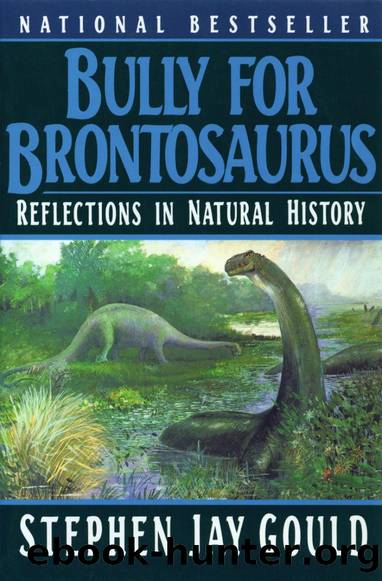Bully for Brontosaurus: Reflections in Natural History by Stephen Jay Gould

Author:Stephen Jay Gould [Gould, Stephen Jay]
Language: eng
Format: epub
ISBN: 9780393340822
Google: TuIVJhHC3fsC
Amazon: 0393340821
Barnesnoble: 0393340821
Goodreads: 10005289
Publisher: W. W. Norton & Company, Inc.
Published: 1991-04-15T05:00:00+00:00
It was, of course, often doneâbut rarely said so boldly and without apology. In any case, Caldwell eventually found the eggs of the platypus (usually laid two at a time and easily overlooked at their small size of less than an inch in length).
Caldwell solved a specific mystery that had plagued zoology for nearly a century, but he only intensified the general problem. He had proved irrevocably that the platypus is a mélange, not available for unambiguous placement into any major group of vertebrates. Geoffroy had been right about the eggs; Meckel about the mammary glands.
The platypus has always suffered from false expectations based on human foibles. (This essay discusses the two stages of this false hoping, and then tries to rescue the poor platypus in its own terms.) During the half-century between its discovery and Darwinâs Origin of Species, the platypus endured endless attempts to deny or mitigate its true mélange of characters associated with different groups of vertebrates. Nature needed clean categories established by divine wisdom. An animal could not both lay eggs and feed its young with milk from mammary glands. So Geoffroy insisted upon eggs and no milk; Meckel upon milk and live birth.
Caldwellâs discovery coincided with the twenty-fifth anniversary of Darwinâs Origin. By this time, evolution had made the idea of intermediacy (and mélanges of characters) acceptable, if not positively intriguing. Yet, freed of one burden, the platypus assumed anotherâthis time imposed by evolution, the very idea that had just liberated this poor creature from uncongenial shoving into rigid categories. The platypus, in short, shouldered (with its interclavicle bone) the burden of primitiveness. It would be a mammal, to be sureâbut an amoeba among the gods; a tawdry, pitiable little fellow weighted down with the reptilian mark of Cain.
Caldwell dispatched his epitome a century ago, but the platypus has never escaped. I have spent the last week as a nearly full-time reader of platypusology. With a few welcome exceptions (mostly among Australian biologists who know the creature intimately), nearly every article identifies something central about the platypus as undeveloped or inefficient relative to placental mammalsâas if the undoubted presence of premammalian characters condemns each feature of the platypus to an unfinished, blundering state.
Before I refute the myth of primitiveness for the platypus in particular, I should discuss the general fallacy that equates early with inefficient and still underlies so much of our failure to understand evolution properly. The theme has circulated through these essays for yearsâladders and bushes. But I try to provide a new twist hereâthe basic distinction between early branching and undeveloped, or inefficient, sturcture.
If evolution were a ladder toward progress, with reptiles on a rung below mammals, then I suppose that eggs and an interclavicle would identify platypuses as intrinsically wanting. But the Old Testament author of Proverbs, though speaking of wisdom rather than evolution, provided the proper metaphor, etz chayim: She is a tree of life to them who take hold upon her. Evolution proceeds by branching, and not (usually) by wholesale transformation and replacement.
Download
This site does not store any files on its server. We only index and link to content provided by other sites. Please contact the content providers to delete copyright contents if any and email us, we'll remove relevant links or contents immediately.
Bad Pharma by Ben Goldacre(3355)
How To by Randall Munroe(3034)
The Book of Numbers by Peter Bentley(2912)
Aliens by Jim Al-Khalili(2787)
A Short History of Nearly Everything by Bryson Bill(2629)
The Meaning of it All by Richard Feynman(2300)
Bill Bryson by A short history of nearly everything(1679)
A Short History of Nearly Everything: Special Illustrated Edition by Bill Bryson(1634)
Elephants on Acid by Boese Alex(1565)
Six Easy Pieces by Richard P. Feynman(1491)
Everything in Its Place by Oliver Sacks(1445)
The Meaning Of It All by Richard P. Feynman(1423)
Glukhovsky, Dmitry - Metro 2033 by Glukhovsky Dmitry(1312)
Bad Science by Ben Goldacre(1297)
When Einstein Walked with Gödel by Jim Holt(1269)
One Two Three ... Infinity: Facts and Speculations of Science by George Gamow(1219)
The American Scene by Henry James(1213)
Leviathan Wakes by James S.A. Corey(1191)
A SHORT HISTORY OF NEARLY EVERYTHING by bryson bill(1186)
